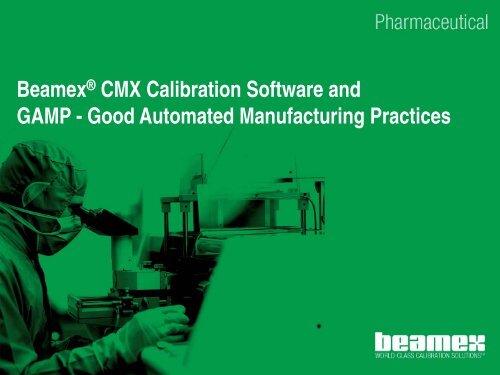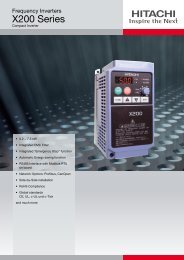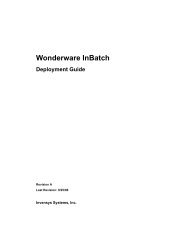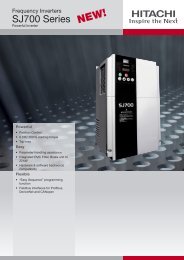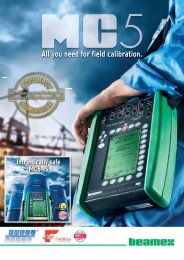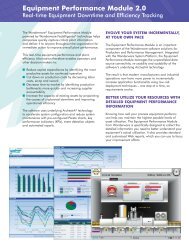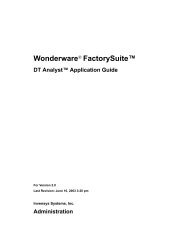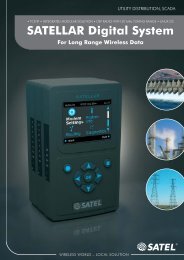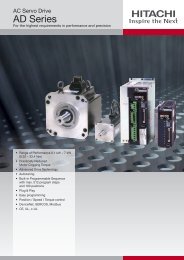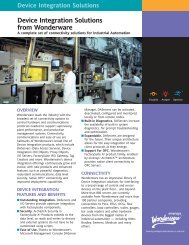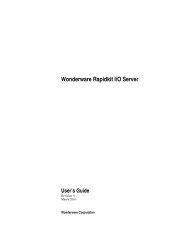GAMP Good Automated Manufacturing Practices - Control System
GAMP Good Automated Manufacturing Practices - Control System
GAMP Good Automated Manufacturing Practices - Control System
- No tags were found...
You also want an ePaper? Increase the reach of your titles
YUMPU automatically turns print PDFs into web optimized ePapers that Google loves.
Beamex ® CMX Calibration Software and<strong>GAMP</strong> - <strong>Good</strong> <strong>Automated</strong> <strong>Manufacturing</strong> <strong>Practices</strong>
<strong>GAMP</strong> <strong>Good</strong> <strong>Automated</strong> <strong>Manufacturing</strong> <strong>Practices</strong>• The <strong>GAMP</strong> Forum was established in 1991 to help promotethe understanding of how computer systems validation shouldbe carried out in the pharmaceutical industry.• Calibration is an essential element in ensuring compliance inthe pharmaceutical industry. To ensure success, calibrationshould be managed effectively by appropriately qualifiedpersonnel with good technical knowledge and practicalunderstanding. If neglected, calibration is capable ofcompromising both production and plant, and dramaticallyincreasing costs.
Key DefinitionsCalibration“The set of operations which establish, under specified conditions, the relationship betweenvalues indicated by a measuring instrument or measuring system, or values represented bya material measure, and the corresponding known values of a reference standard”.Validation“Action of providing, in accordance with the principles of <strong>Good</strong> <strong>Manufacturing</strong> <strong>Practices</strong>(GMP), that any procedure, process, equipment, material, activity or system actually leadsto the expected results”.Qualification“Action of proving that any equipment works correctly and actually leads to the expectedresults. The world ‘validation’ is sometimes widened to incorporate the concept ofqualification”.(Rules and Guidance for Pharmaceutical Manufacturers and Distributors, MAC, 1997)
ResponsibilitiesProcess OwnersTo identify the critical parameters, the processvariables, and to derive acceptable limits.Quality Assurance (QA)To verify the limits are acceptable and ensurethat parameters meet regulatory compliance.EngineeringTo propose the use of suitable instrumentationand asses whether instruments are fit forpropose.
Key Regulatory Requirements1. Each instrument should have a permanent master history record.2. All instrumentation should be assigned a unique number and all product, process,and safety critical instruments should be physically tagged.3. The calibration method should be defined by approved procedure.4. Calibration frequency and process limits should be defined for each instrument.5. There should be a means of readily determining the calibration status of eachinstrument.6. Calibration records should be maintained.Continue…
Key Regulatory Requirements6. All electronic systems used for calibration management for systems, which affectsproducts for supply to the USA must comply with the Food and Drug Administration(FDA) “21 CFR Part 11 – Electronic Records, Electronic Signatures”.8. Calibration measuring standards should be more accurate than the requiredaccuracy of the instrument that is being used.9. Each measuring standard should be traceable to a nationally, or internationally,recognized standard, where one exists.10. All instruments used should be fit for propose.11. There should be documented evidence that personnel involved in the calibrationprocess have been trained and are competent.12. A documented change management system should be established.
Back to MenuMaster History Record
Back to MenuAssign a Unique Instrument Number
Back to MenuApproved Procedure
Back to MenuCalibration Frequency
Back to MenuProcess Limits
Back to MenuThe Calibration Status
Back to MenuCalibration Records
Back to Menu21 CFR Part 11 – ER, ES• The FDA’s view is that the risk of falsification, misinterpretation, and change withoutleaving evidence are higher with electronic records than paper records, and thattherefore specific controls are required.Key Regulatory Requirements• Technology, <strong>System</strong> should allow applicable electronic data to be accessed inhuman readable form. <strong>System</strong> should be able to maintain applicable electronic dataover periods of many years.• Security, <strong>System</strong> should restrict use of system functions and features in accordancewith configurable rules that can be maintained. <strong>System</strong> should force to give uniqueelectronic signature when electronic record is created, modified or deleted.• Audit Trail, <strong>System</strong> should be able to identify changes to electronic record in orderto detect invalid or altered records.
Back to MenuStandard More Accurate than Instrument
Back to MenuStandard Should be Traceable
Back to MenuInstruments Used Should be Fit for Propose
Back to MenuPersonnel Trained and Competent
Back to MenuDocumented Change Management
Back to MenuAccessed in Human Readable Form
Back to MenuRestrict Use of <strong>System</strong> Functions
Back to MenuElectronic Signature
Back to MenuIdentify Changes to Electronic Record


